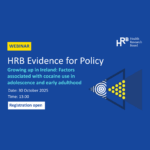Gabapentinoid linked deaths rise 35% a year, new study finds
Dr Seán Millar reports on a decade-long national study that reveals a sharp rise in prescribable drug misuse in Ireland, with women more likely than men to misuse pregabalin
3 min read - 29 Oct 2025

Gabapentinoids, powerful prescription drugs for the treatment of nerve pain and epilepsy have become Ireland’s fastest-rising drug misuse threat, according to a new national study.
The research, led by Dr Louise Durand of the Royal College of Surgeons, found deaths linked to gabapentinoids, particularly pregabalin, increased 35% each year between 2010 and 2020.
The study, which analysed three national health datasets, paints a stark picture of how prescription drug misuse has evolved in Ireland over the past decade. It highlights not only the growing misuse of pregabalin, but also the persistent dangers of benzodiazepines and opioids – especially when used in combination.
Using data from the National Drug Treatment Reporting System, the National Self-Harm Registry Ireland, and the National Drug-Related Deaths Index, the researchers examined four categories of prescription drugs with high misuse potential: benzodiazepines and so-called z-drugs, prescription opioids, gabapentinoids, and psychostimulants.
Benzos still most harmful
Despite the rapid rise of pregabalin misuse, benzodiazepines and z-drugs remained the most consistently harmful drug class across all indicators. They were involved in 341 per 1,000 treatment cases, 408 per 1,000 intentional drug overdoses (IDOs), and 546 per 1,000 drug-related deaths (DRDs).
While the overall burden of harm from benzodiazepines remained high, the study noted that the rate of increase was relatively modest. However, it flagged a worrying trend: the growing presence of alprazolam (Xanax) and the newer substance, etizolam, in fatal overdoses.
Rapidly escalating threat
In contrast, gabapentinoids – and pregabalin in particular – showed the steepest rise in harm. Treatment-demand linked to these drugs grew by 44% annually, while IDOs rose by 9% per year.
The study links this surge to increased prescribing and the misuse of pregabalin in combination with other substances, especially opioids and benzodiazepines – a mix that can be deadly.
Prescription opioids, including tramadol and codeine, were the second-most-common drug class involved in drug-related deaths, accounting for 207 per 1,000 fatalities. However, their misuse remained relatively stable over the study period.
Psychostimulants played a minimal role in treatment cases, overdoses, and deaths, suggesting that their misuse is currently limited in Ireland compared to other prescription drugs.
Gender differences in polydrug use
The study also highlighted the dangers of polydrug use, where multiple substances are taken together. This practice significantly increased the risk of harm, particularly when gabapentinoids were combined with benzodiazepines or opioids.
The trend was especially pronounced among women, who were more likely to misuse gabapentinoids and opioids. Men, on the other hand, were more likely to misuse psychostimulants and certain benzodiazepines.
The authors of the study argue that the findings point to an urgent need for action. They recommend:
- Closer monitoring of prescribing practices
- Assessing patients’ risk of misuse, especially for high-risk drug combinations
- Reclassifying pregabalin as a controlled drug
- Improving prescription monitoring systems
- Launching public education campaigns to raise awareness
The study builds on earlier signals identified in 2019 by the Ana Liffey Drug Project in collaboration with the HRB which is the Irish Focal Point of the European Union Drugs Agency. This study had already flagged rising misuse of prescribable drugs among high-risk groups, including people in prison, those with complex needs, and young people.
As Ireland continues to grapple with the consequences of drug misuse, this research provides a clear and data-driven warning: the misuse of prescription drugs, particularly pregabalin, is not only rising – it is becoming more deadly.
Reference
ENDS
3 min read - 29 Oct 2025



